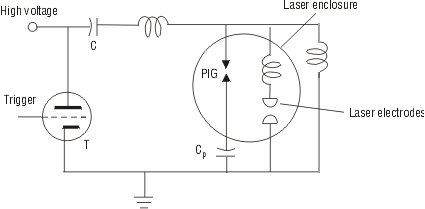So looking at this:

What the Pre-Ionized Gap (PIG) and the Thyratron (T) form is a spark-gap flyback impulse generator. Pretty much the same kind of deal that Hertz used to prove the existence of wave propagation, just much, much more precise, shorter, higher energy impulses, and also, the flyback energy is used to excite a laser.
So, if you stick with that design, you'd need something that can short 20kV very quickly, and even more important, open the circuit at least as sharply.
Note that 20kV is indeed a bit at the upper end of semiconductor device's range – but it's kind of hard to say that it's impossible to use semiconductors for this purpose; in the end, Gigawatt High-Voltage Direct Current rectifiers/inverters are built from thyristors and even insulated-gate bijunktion transistors these days!
However, your single semiconductor device will utter a last "poof" if you expose it to 20kV. You need to connect a set of thyristors in series to divide the voltage evenly across them, in able to allow each thyristor to withstand that voltage.
That also means that you need very precisely control them, so that not one thyristor is switched "on" after the others – if that happened, all the voltage would accumulate over that late thyristor, and that would lead to damage (experts speak of the magic blue smoke coming out of the device, and in the case of a 20kV supply, also probably: fire).
Then, turning a thyristor off is a pretty complicated business. In the case of the circuit above, you'd have to make sure the energy stored in the inductors is large enough to quickly reverse the current direction, leading to a temporary drop in current flowing through the thyristor so that it declines beneath the hold current. But that reduces your design freedom. Also, you want to be 100% sure that happens, because otherwise you'll either damage your thyristor array or your voltage supply. Still, turning of a silicon thyristor takes about 100 µs – 0.5 ms citation needed and that is very likely not fast enough for this application.
Only in the ca. last ten years (and the page where the image is taken from is from 2001 – and thus predates) technological advantages in the production of hybrid semiconductor devices that integrate e.g. thyristors, MOSFETs to switch the transistor gate current, and bipolar transistors to coordinate the MOSFETs on one semiconductor die allow to replace some of the very special-purposed tube components, and that not necessarily at lower cost or higher safety.

